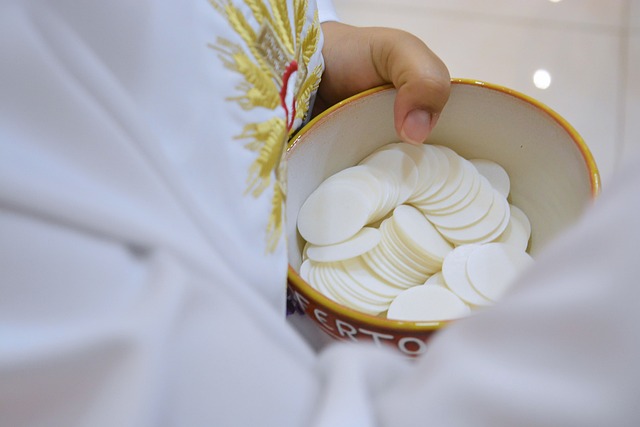
Introduction
The Transfiguration of Jesus stands as a remarkable event in the Gospel narrative, a moment where the divine glory of Christ is revealed to his disciples. The encounter atop the mountain, as recounted in Matthew 17:1-9, offers profound insights not only into Christ’s identity but also into its connection with the sacrament of the Holy Eucharist. Drawing from Daniel 7:9-14 and 2 Peter 1:16-19, we will explore how the Transfiguration provides a unique perspective on the Eucharist, reinforcing the divine relationship between Jesus’ identity, his teachings, and the sacred act of partaking in his body and blood.
Transfiguration: A Glimpse of Divine Glory
The Transfiguration unveils the radiant splendor of Christ, reminiscent of the glorious appearance of God as described in Daniel 7:9-14. In this Old Testament prophecy, the “Ancient of Days” is depicted in majestic glory, surrounded by countless heavenly attendants. This imagery magnificently conveys the divine authority, power, and sovereignty inherent in Jesus, the Son of God. The parallel between Daniel’s vision and the Transfiguration highlights the continuity of God’s divine plan, where Jesus fulfills the promises made in the Old Testament.
The Transfiguration and the Beloved Son
The heavenly declaration, “This is my Son, the Beloved; he enjoys my favor. Listen to him,” not only echoes the words spoken at Jesus’ baptism but also carries profound implications for the Holy Eucharist. The title “Beloved” emphasizes the unique relationship between Jesus and the Father, accentuating his divine nature. As the Father’s Beloved, Jesus’ teachings are of utmost importance, guiding our understanding of the Eucharist as more than a symbolic ritual.
Listening to Jesus holds particular significance in our approach to the Eucharist. His words are the foundation upon which the Eucharistic celebration rests. When we listen to him, we hear his invitation to partake in the mystical banquet where he offers himself as the Bread of Life. The Transfiguration’s command to listen resonates within the Eucharistic context, urging us to attentively engage with Christ’s presence, teachings, and sacrificial offering.
Transfiguration, Eucharist, and Transformation
2 Peter 1:16-19 provides a retrospective lens through which we can view the Transfiguration’s connection to the Eucharist. Peter’s testimony as an eyewitness underscores the event’s authenticity and its transformative impact. The dazzling light on the mountain is echoed in the radiance of the Eucharist, where the bread and wine are transformed into the body and blood of Christ.
The Transfiguration’s transformative quality is mirrored in the Eucharist’s power to transform us. Just as the disciples were changed by encountering Christ’s glory, we are invited to be transformed by partaking in his body and blood. The Eucharist serves as a conduit for grace, renewing our spirits, cleansing our souls, and drawing us closer to the divine life.
The Ultimate Focus: Only Jesus
The Transfiguration’s pivotal moment, where the disciples see “no one but only Jesus,” resonates profoundly with the essence of the Holy Eucharist. In this sacred act, we encounter Christ in his entirety. Just as Moses and Elijah faded into the background, the Eucharist redirects our attention solely to Jesus – his presence, his sacrifice, and his divinity.
The Eucharist enables us to behold Jesus in a unique manner, not just symbolically, but sacramentally. In the consecrated elements, we find his real presence – body, blood, soul, and divinity. This encounter transforms the Eucharistic celebration into a deeply personal and intimate experience with the Lord.
Transfiguration and Eucharist: The Ultimate Revelation
The Transfiguration and the Holy Eucharist converge in their revelation of Jesus as the fulfillment of God’s promises. The Old Testament foreshadowing of God’s glory in Daniel’s vision finds its realization in Christ’s luminous transformation. Similarly, the Eucharist, established during the Last Supper, bridges the Old and New Testaments, encapsulating the culmination of God’s salvific plan.
As we contemplate the Transfiguration, we’re invited to reflect on the Eucharist as the sacramental embodiment of Christ’s identity and teachings. Just as the disciples were transformed by their encounter with Christ’s glory, we are transformed by our participation in the Eucharist. It nurtures our communion with Christ and fellow believers, reinforcing our identity as the Body of Christ.
Conclusion
The Transfiguration serves as a bridge between the earthly and divine realms, offering a glimpse of Christ’s radiant glory. This momentous event finds resonance in the Holy Eucharist, where we encounter Christ’s real presence in the consecrated elements. The connection between the Transfiguration and the Eucharist highlights Jesus’ identity, his teachings, and the transformative power of his sacrifice.
As we partake in the Eucharist, may we remember the words spoken on the mountain: “This is my Son, the Beloved; he enjoys my favor. Listen to him.” Let us listen intently to Christ’s invitation, allowing the Eucharist to transform us, drawing us into deeper communion with the Beloved Son and revealing the divine splendor that beckons us beyond the earthly horizon.






